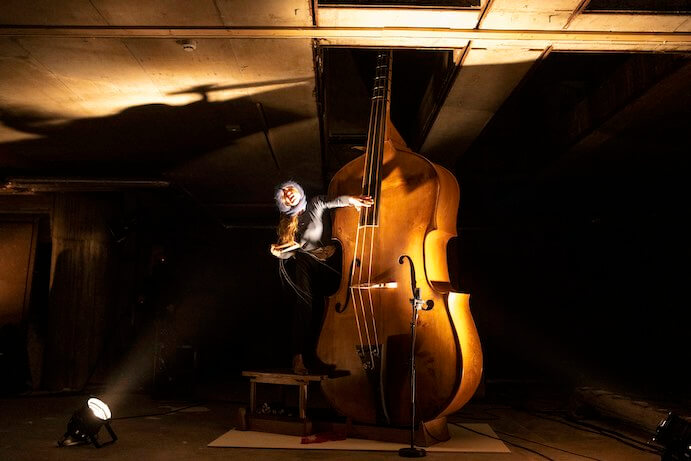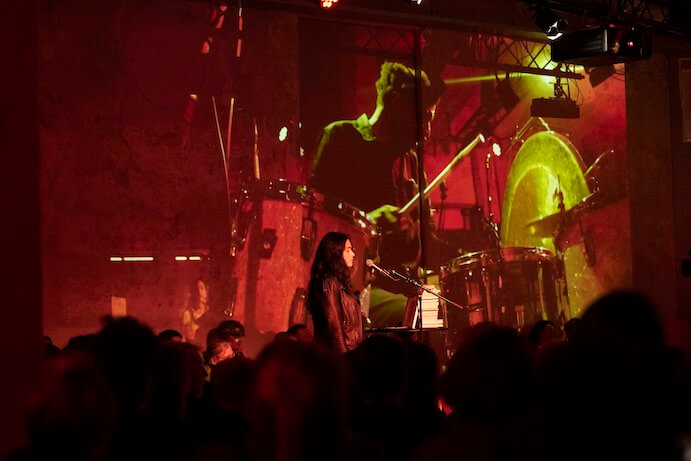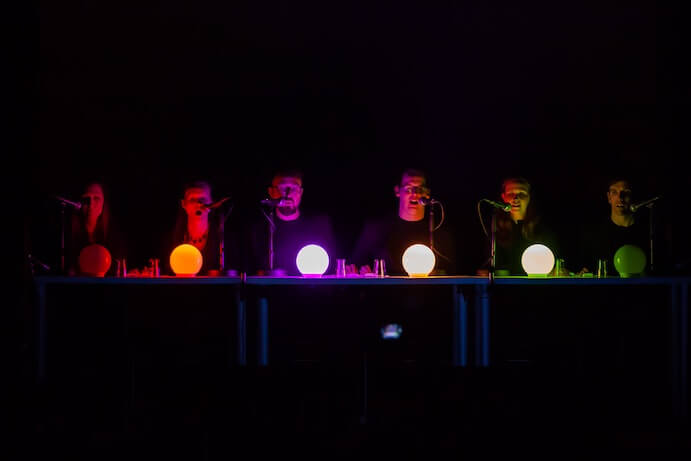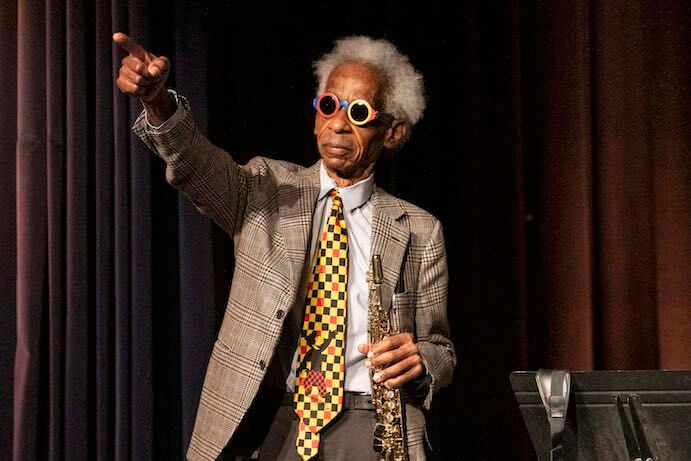Our concept of time over the past couple of years has become a bit amorphous – moments expanding and contracting in unnatural ways as we navigate cycles of isolation. Having virtually gone nowhere and done nothing in over two years, venturing out to Bergen, Norway for the 2022 iteration of Borealis – en festival for eksperimentell musikk gave me a reinvigorated love for new and experimental music and the artists creating it. With no official strapline for this year’s program, the ways in which we experience, process, and document time emerged as a throughline, with many of the works dealing with memory, historical narratives, creative gestation, and meditation.
“I’m working with my level of energy,” said a sleepy, quiet voice in Jenny Berger Myhre’s Slowly I wake up to my other life, commissioned for Borealis’ Radio Space and transmitted across the city’s peninsula during the “Resonating Nordes” installation. Cast atop gentle ambient soundscapes, the narrator recounted dreams, unearthed memories of past musical experiences, and wondered if we perhaps needed more room for silence in our pre-pandemic lives. Crafted with Myhre’s trademark honesty and vulnerability, the intimate work was an ode to careful listening and internal reflection.
Also part of “Resonating Nordes” was What Will Be Lost, a collaboration between US-based Indigenous artist Autumn Chacon and Sámi activist/artist Sandra Márjá West. Broadcast at Nordes Park, a spoken statement of support for the Sámi people condemned the German Copper Buying Industry’s mining in Sápmi, but this was interrupted and obscured by field recordings of nature. And while unintentional, the added difficulty in finding a clear connection on my portable FM radio at the park left me searching for these signals of solidarity, underscoring the ways in which the voices of Indigenous people are often silenced. (Fortunately, it was possible to catch a hi-fi stream of the work in Borealis’ listening room.)

The effects of oppressive patriarchal, colonial, and capitalist systems also reverberated through Guro Skumsnes Moe’s Resonant Silence, presented in the dank and cavernous abandoned grain silos beneath the Bergen School of Architecture. Wandering around the dimly lit basement, mallets struck on the walls harnessed the acoustics of the space, the haunting metallic twang of a lofted kantele echoed from above, and a horrific, monstrous scream escaped from a saxophone in the silo. Creaks of vocal fry and eerie cello harmonics conversed with the formidable vibrations of an octobass before the primordial call of bagpipes ushered the audience back out into the daylight. Throughout the immersive work, mossy branches scattered on the concrete and the pungent smell of grain enhanced the multi-sensory experience.
Marshall Trammell addressed similar themes of solidarity and resistance narratives by harnessing knowledge encoded in art as a means of emancipation. As Borealis Artist-in-Residence for the past two years, the long development period given to his new work included creative workshops, space for ideation, and the time needed to build relationships with collaborators and produce a co-created work.
For The Moon is Down: The Status Quo is My Enemy, Trammell invited four women of color living in Bergen (Anine Fatou Bråten, Dora Poni J. Loro, Carol Stampone, Wengeal Abebe) to create a narrative about their experiences with racism and feelings of alienation from Scandinavia’s purported egalitarian values. Using branding irons on wooden canvases, the women created contemporary quilt codes to symbolize their experiences, reclaiming tools of oppression to produce artifacts of the creative process and communicate the resonances of colonial violence. The ideas generated in the quilt code workshop led to a collective writing of the text, which was ultimately accompanied by Trammell on a massive multi-percussion set-up during the performance.

At the premiere, the audience literally centered the five creators by encircling them in the industrial performance space at Bergen Kjøtt, a former factory turned cultural center. Each of the four women took turns reading an excerpt of their writings, with drums anxiously percolating under the surface. À la Alvin Lucier, these recitations were recorded and played back as brutally pounding toms, cracking rimshots, and unrelenting kick drums drowned out the words, effectively erasing the documentation of each woman’s experience. And yet the emotional resonance of their words could still be viscerally felt vibrating through the body via the rhythm and contour of their recorded speech. This pattern of live recitation and recorded playback repeated several times, with the immense concentration, physicality, and intentionality of Trammell’s drumming deftly shaping the overall arc of this gripping and vitally important work.
Similar to Borealis’ Artist-in-Residence program, Borealis Ung Komponist (Borealis Young Composer) is a creative incubator that allows relationships and ideas to develop slowly over time while also providing mentorship, workshops, and access to a collaborative partner ensemble. The 2022 cohort of young music creators produced one of the strongest programs I’ve seen from this initiative to-date, and while most of the pieces would have benefitted from some editing, the concert featured compelling and innovative ideas, performed by the outstanding vocal sextet TABULA RASA.

In Mirsaeed Hosseiny Panah’s Textual Memories, Persian modes and Western classical music combined to produce lilting, hocketed exchanges that emerged and receded like swirling spectres of distant memories. Karoline Wallace’s Nær adeptly exploited the acoustics of Bergen Domkirke with heterophonic folk-like melodies calling to each other from a distance. A magnificent tangle of flexible plastic tubing in the center aisle unfurled into the far corners of the space, allowing performers singing into the tubes to create the stunning effect of throwing their voice across the space. Astrid Solberg’s captivating healing pamper, no talking explored ASMR-inspired sounds of hissing, breathy vocalizations, puckering, purring, trilling, whistling, and vocal fry, all uniquely activated by a colored orb situated in front of each performer. And Peder Niilas Tårnesvik’s gorgeous Vi Beveger Oss Sammen featured shifting ambient soundscapes, each imbued with a deep feeling of peace and meditative calm. A particularly luscious passage featured harmonies adorned with buzzing “zz’s” that textured the resonance.
Speaking of works that have been given the gift of long periods of development, the Norwegian Naval Forces Band premiered a new version of Roscoe Mitchell’s NONAAH, which has been constantly shapeshifting in the 48 years since the emergence of the original solo saxophone version. Unfortunately, the acoustics of the performance space were at odds with the contrapuntal complexity of the orchestration and the angular virtuosity of the piece, but luckily there were plenty of other opportunities to engage with Mitchell’s work throughout the festival. The File Under Freedom exhibit at Bergen Kunsthall showcased Mitchell’s paintings alongside pieces by Lisa Alvarado, Don and Moki Cherry, Douglas R. Ewart, Milford Graves, Thaddeus Mosley, Matana Roberts, Marshall Trammell, and many more as the iconic refrain of Space is the Place looped ad infinitum with a particularly cosmic photo of Sun Ra looking on. And the closing concert saw Mitchell collaborating with himself across space and time, improvising with a performance film created at home in Wisconsin prior to the festival guest starring Shuggie, his golden lab with a penchant for vocalizing.

Among the festival’s meditative, long duration works – which included Rolf Gupta’s In Memoriam and the mammoth, three-hour Fractured Times. A Reunion of Strangers by Ensemble neoN, FEN (Far East Network), and Lasse Marhaug – the standout was the world premiere of Catherine Lamb’s microtonal marvel, inter-spatia, for three tubas and four trombones. An unhurried 45-minute build of the overtone series in just intonation created an atmospheric transfiguration of sound culminating in a resplendent, cascading finale. The smart pacing of the composition allowed the ear to become highly attuned to the unique beats of each interval, and the experience of listening became less about the harmony itself and more about the physical embodiment of the vibrations inside the glorious Nykirken.
I have to conclude with a word of appreciation for Borealis’ approach to making the festival accessible using what we’ve learned from pandemic-necessitated virtual events. Even though I was physically present in Bergen, I ended up experiencing a major autoimmune flare that left me feeling quite sick for much of the week. But several of the performances and panel discussions were available for free online via high-quality Vimeo streams that featured multiple camera angles and excellent audio quality, and many of the other events were broadcast via Facebook Live and Instagram Live. These efforts allowed me to join events from my hotel room when I wasn’t feeling well, whereas I might have missed the experience altogether if not for this hybrid approach. It’s my sincere hope that as we continue our return to live performances, we continue to uphold the accessibility benefits of streaming.
Borealis’ programming always impresses year-after-year, affording both new attendees and returning audiences the opportunity to engage with radical artists and ideas. But beyond merely curating and presenting an annual festival, it’s clear how much relationships matter to the organizational leadership — and it’s this human connection that we’ve perhaps been missing most of all throughout the pandemic. As institutions make efforts to diversify their programming, the importance of seeing each other as human beings is often forgotten in the pursuit of better optics, but Borealis’ genuine and supportive relationships with artists continue to be a prime example of community building done right.
I CARE IF YOU LISTEN is an editorially-independent program of the American Composers Forum, funded with generous donor and institutional support. Opinions expressed are solely those of the author and may not represent the views of ICIYL or ACF.
A gift to ACF helps support the work of ICIYL. For more on ACF, visit the “At ACF” section or composersforum.org.
























